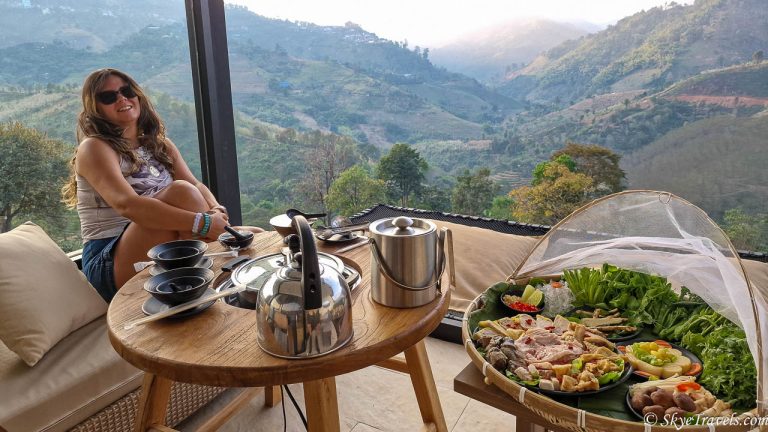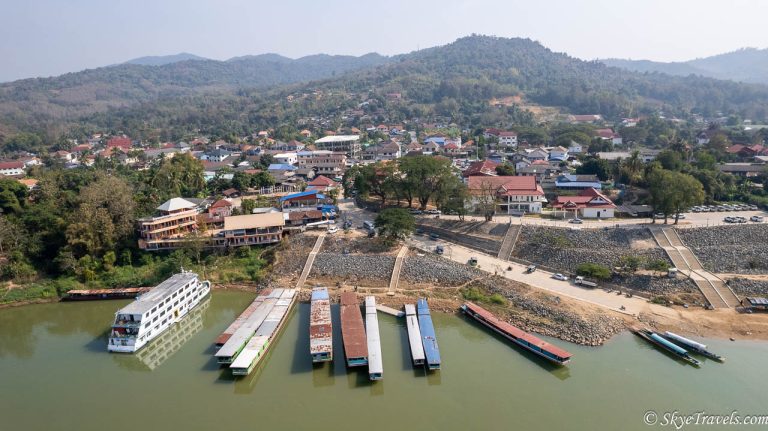The Highland Wildlife Park in the Cairngorm National Park of Scotland is the second attraction managed by the Royal Zoological Society of Scotland (RZSS). It’s where they breed and house those animals needing a wilder setting than a zoo in Edinburgh.
Driving to the Highland Wildlife Sanctuary
The Highland Wildlife Park is located 130 miles north of Edinburgh, halfway up the Cairngorm National Park on the way to Inverness. If you want to go by public transportation from Edinburgh, you can take a bus or train to Perth and then another bus or train to Aviemore. From there, take the 32 or 35 bus to the park. Just know that this route takes about four and a half hours! Better is to rent a car. The drive takes about two and a half hours, depending on traffic. Either way, the scenery on the way up is stunning. This is Scotland after all.
Another option is to spend the night closer to the park. Inverness is an hour to the north and Pitlochry is an hour to the south. Pitlochry is a small, quintessential Scottish town and has a backpackers hostel, but it fills up in the summer. There are also plenty of B&Bs across the Scottish countryside.
If you do choose to drive, make sure you follow Google Maps closely. You have to get off the highway a couple miles before the park. Otherwise, it’s a few miles before you can turn around. You definitely want to bring your own vehicle, not just because they have free parking but so you can drive through the Main Reserve.
Lunchtime for the Amur Tiger
We got to the park a bit later than we should have and just missed the talk on the snow leopards. Thankfully we were on time for the tiger feeding and headed there first. This was so much different than the tiger attractions in Thailand. Dominika is the park’s resident tiger, and she’s a beauty!
I learned some really interesting facts about this breed of tigers. First of all, it was formerly called a Siberian tiger but they’re believed to be extinct in Siberia and only extant in the far east of Russia, a little into China, and possibly in North Korea. The Amur River runs through the center of their remaining habitat, which is why they were named after it. Dominika was born at the Highland Wildlife Park in May of 2009. On May 28, 2013, she gave birth to two male cubs which later were sent to other breeding programs in Europe.
We arrived at the enclosure just minutes before feeding time began. Instead of some spectacle of trainers throwing food at the tiger, Dominika had to search around her large enclosure to find where the keepers had hidden large chunks of meat, simulating a more natural environment. While this was going on, the keeper gave a talk about this majestic animal. Sadly, we missed Dominika’s mate by a couple months. He passed away from some medical problems unrelated to a dental surgery he was getting.
Adorable Arctic Foxes
Near the Amur tiger are the Arctic foxes. A male and female named Bard and May gave birth to a litter of 10 cubs in May this year. They are now nearly as big as their parents. We missed the talk but some of the foxes were quite active and fun to watch…probably because it was around their feeding time too. The little cubs were just adorable running around and wanting to discover everything in their enclosure. They certainly weren’t afraid of people either, and mostly just ignored us as they went about doing their own thing.
The Arctic fox has been extinct in Scotland since the last ice age, but the breed is flourishing in other places. I’m personally curious if they have plans to reintroduce the fox into the British Isles. I don’t know how it would affect the current ecosystem, but after seeing how adorable those cubs were, I’d hope to see them running around the Scottish countryside someday in the future. Well, there are other fox breeds running around the UK; we saw one just a couple days ago driving across Scotland.
Scotland’s First Snow Leopard Cubs
By far the highlight of our trip was the snow leopard enclosure at the top of the hill. In the first couple weeks of August 2019, the female snow leopard Animesh gave birth to three cubs. As far as I can tell, these were the first snow leopards born in Scotland. Snow leopards are listed as vulnerable, a threatened category but not as bad as endangered. There are about 4,500 to 7,300 in the wild throughout central Asia.
Snow leopards are solitary creatures so the male and female are kept separate at the Highland Wildlife Park, although the enclosures are next to each other which allows the male to keep an eye on things. There was a gaggle of photographers keeping an eye on things too. Apparently they had been there every day since the cubs were made known to the public. I could easily see why. We must have spent half an hour there. Two of the cubs were already asleep, but one was quite boisterous. For easily half an hour, we stood there watching him frolic about, tease his mom and try to climb a wooden log to a higher portion of the enclosure before his mom could swat him off.
By far the funniest part was when the cub came up to the glass to find out what we were about. After a minute or so, his mom called him back. When he reached her, she smacked him in the head, and then repeatedly did so several more times before dragging him back to the den for a nap. My partner caught everything on video! After all, striking a child is illegal in Scotland.
Driving Through the Main Reserve
Half an hour before the park closes is the last chance you get to drive through the Main Reserve. This is where they keep the animals that have no problem interacting with humans as they drive past. Przewalski’s horses (another endangered species at the park), vicuna (similar to a llama), red deer, Bukhara deer, European elk and European bison are the animals walking about. Most were happy to graze by the side of the road. It took about 20 minutes to complete the circuit, although the car behind us took longer as the bison decided to finish their meal in the center of the road.
The entrance of the park is another drive-through where you can see Bactrian camels, yaks, white-lipped deer and Mishmi takin (an endangered goat-antelope from northern India). You’re not allowed to get out of your car or feed the animals in either of the drive-throughs, but you can have the windows down and the animals might come right up to the car.
Returning for More
The other attraction we really enjoyed was the polar bear enclosure. Victoria, the female polar bear, gave birth to a cub in December 2017. By now, he was almost her size, although still considerably smaller than the two male polar bears which are kept in a separate enclosure by the Main Reserve. They all were doing their usual activity of napping while we watched, but it was still nice to see them in person. The polar bear is classified as vulnerable rather than endangered, but the park is still doing its part in the breeding program.
There were more than a dozen other animals throughout the park. Similar to the Edinburgh Zoo, this isn’t a display of captured animals but rather a conservation and breeding program. A big difference to the Edinburgh Zoo is that the animals at the Highland Wildlife Park are much more active. At the zoo, most of the animals I saw were sleeping. At the park, it was only the polar bears and red pandas that were napping.
The park is open from 10 a.m. until 4 to 6 p.m. (depending on the month) every day of the year except for Christmas Day. While the park isn’t particularly big, there are talks throughout the day for many of the animals, and you can drive through the Main Reserve as many times as you want. Nevertheless, it’s the kind of place I’d love to return to many times. If I do end up spending more time in Scotland in the next year, I’ll definitely have to get my RZSS membership for the Edinburgh Zoo and Highland Wildlife Park, which also gets me free access to 13 other zoos in the UK and Europe. Besides, I need to hear the rest of the talks at the Highland Wildlife Park and see those adorable snow leopards again before they’re sent off to other breeding programs.
Quick Facts
- Location: Kincraig, Kingussie PH21 1NL Scotland
- Hours: July-Aug – 10 a.m. to 6 p.m.; April-Oct – 10 a.m. to 5 p.m.; Nov-Mar – 10 a.m. to 4 p.m
- Price: Adult – £17.95 ($22.95); Child – £9.95 ($12.25) Save 10% when booking online!
- Website: Highland Wildlife Park
- What to bring: Walking shoes, a poncho if it’s raining, and your camera.
Click to Pin It
Further Reading
Don’t fancy going to the Highland Wildlife Park? Here are some other places to eat at, and activities to partake in around Edinburgh.
- Seeing the Penguins and Pandas at the Edinburgh Zoo for My Birthday
- 5 Amazing Cafes and Restaurants in Edinburgh That I Frequent
- Best Places to Eat in Edinburgh on a Budget
- How to Find the Best Brazilian Crepes in Edinburgh
- The Village Hotel in Edinburgh is So Much More Than a Hotel
- There’s a Cat Cafe in Edinburgh!
- Enjoying the Happiest Place in Scotland at Edinburgh’s Chihuahua Cafe
- Begin Your Journey in Scotland with a Secret Food Tour in Edinburgh
- What the Da Vinci Code Didn’t Show You About Rosslyn Chapel
- Camera Obscura in Edinburgh Brings Out the Kid in You
- Experience the Underground Preservation of Mary King’s Close
- Escape Edinburgh: The Most Fun Activity in Edinburgh’s New Town
- Finding the Best Ghost Tours in Edinburgh
- Riding the Most Delicious Tour in Edinburgh on the Red Bus Bistro
- 9 Free Attractions to Visit in Edinburgh
- 10 Activities for The Perfect Day Trip from Edinburgh
Here’s some extra reading to save hundreds on your next vacation or stage of your journey.
- 5 Steps to Book Cheap Flights
- Hostels: To Book or Not to Book
- Is Workaway Worth it for the Traveler?
- Click here to claim your $25 credit with AirB&B
This post may contain affiliate links. These links help give me the wherewithal to continue traveling at no additional cost to you. For more information, click here.













